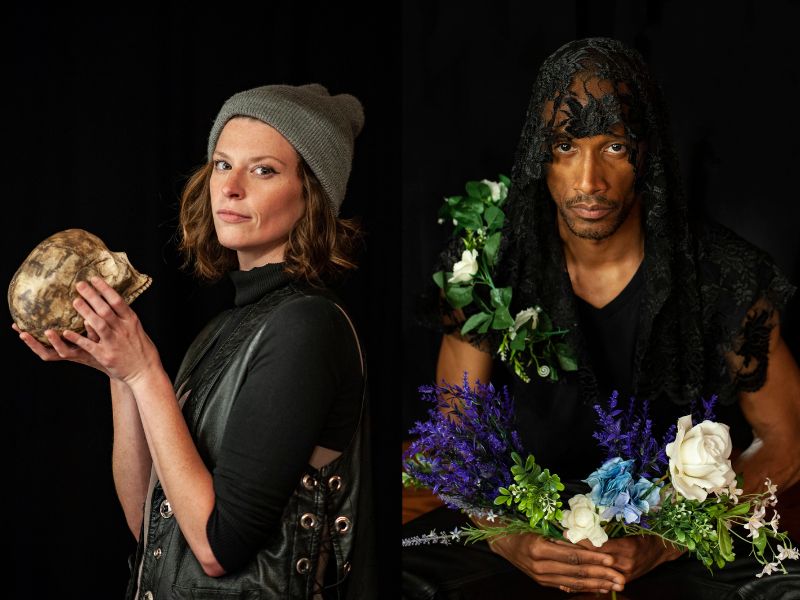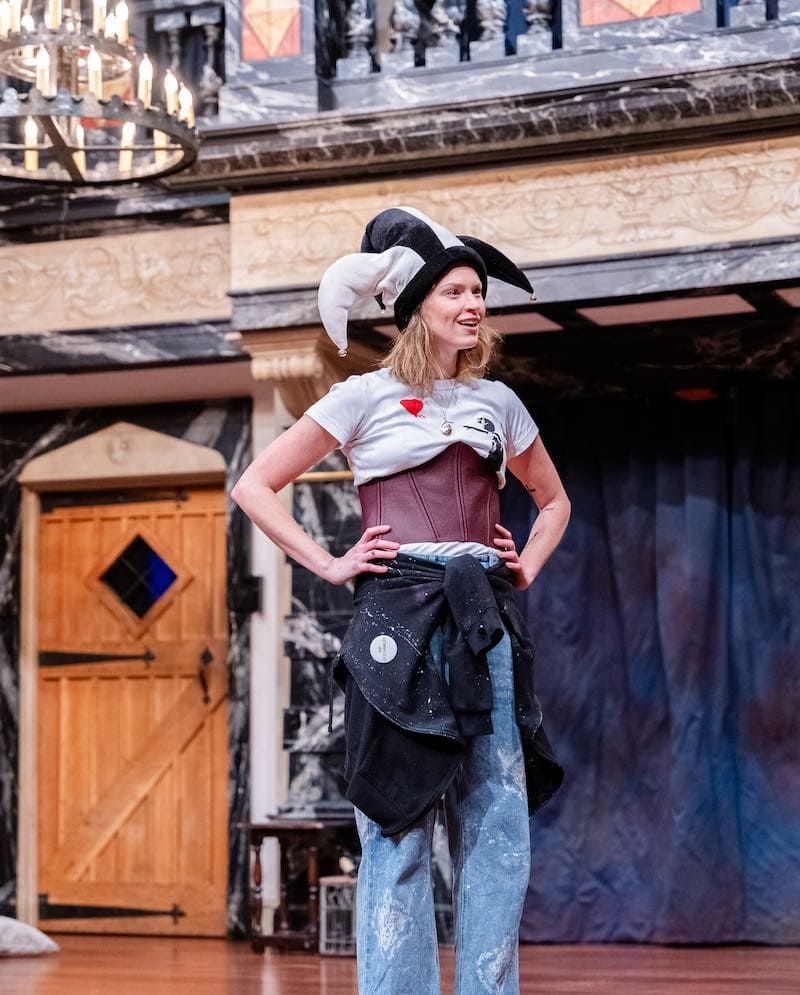There comes a time in an actor’s career when they’re finally ready: ready to tackle one of the greatest stage roles of all time—Hamlet. And if you’re lucky you also have good colleagues, and a fine director, to guide you through the preparations for it.
And if you’re even luckier, you have the time and the space to make the role entirely your own.
Such a time has come for the American Shakespeare Center’s Meg Rodgers, one of the finest and most versatile actresses on the American stage. Her Royal Dane is intensely personal, and for that our melancholy prince should be forever grateful.

You know you’re in for a truly compelling evening when Rodgers first appears on the stage, during the Blackfriars Playhouse’s traditional pre-show; while castmate Jess Kadish sings Labyrinth’s ballad “Jealous,” Rodgers performs a pantomime of a daughter in grief, holding mementos—a teddy bear, an old baseball glove—and then, huddled in an old chair, watching a home video that brings her to laughter, then to tears. A whole world of emotions washes across her face, a preview of the roller-coaster ride her Hamlet is about to offer us.
Director Cameron Knight has generously given Rodgers a chance to explore the character, and the play, in ways that constantly surprise; having seen many Hamlets in my time (and having performed the role myself), I feel the key to any great production is the willingness to avoid the tried and true, the “expected” in the play; and there are surprises galore, along with a few star turns. Rodgers’ very first soliloquy, “O, that this too, too solid flesh,” cuts to the bone with its intimacy and its daring.
Hamlet belongs to all of us, of course, and we have long grown out of the notion that Hamlet is for boys only. Women have proven, time and again, that when they take on traditional male roles in Shakespeare, the drive and the passion reside in their hearts as well. It is simply a matter of giving them room to show how they can embody them.
Which leads to the next question, which Cameron’s production raises and answers: If women can fully embody canonical male roles, can a man adopt one of Shakespeare’s canonical female personae? One that reveals a side of the male psyche that men, as a rule, are taught never to reveal?
Here too, the answer is original and compelling; for opposite Meg Rodgers’ Hamlet is ASC’s Artistic Director Brandon Carter, he of the tall stature, broad shoulders, and magisterial voice, playing Ophelia. Once you let go of all your assumptions about tall, deep-voiced Black men, with their alleged bravado, Carter reminds us of the deep emotional vulnerability that resides in men as well, if only we’re given permission to reveal it.

As Rodgers re-embodies Hamlet, so Carter re-embodies Ophelia, who is just as helpless and desperate as ever. From the first secret, furtive gesture of affection Ophelia makes toward Hamlet, we know Carter is willing to go places we’ve never seen him go before. And when his Ophelia breaks down, after her father’s murder, the splintered personality is reflected in Carter’s self-debasement, evoking the ghosts of minstrelsy as the ultimate sign of Ophelia’s madness.
Rodgers and Carter have solid support in all the other roles, and space will not allow me to mention them all, so what follows is by no means exclusive of all the talent on display here: Angela Iannone’s Polonius is as cunning a turn as I have ever seen, and Erica Cruz Hernandez has the opportunity to show her talents in a serious role (having already mastered Shakespearian comedy numerous times on this very stage). Matthew Henerson’s Claudius is as blustery as he is haunted. Henerson’s attempt to pray in the chapel (after the play within the play) creates all the tensions of a guilty creature, trying to figure out how on earth repentance might work. Meanwhile, Jess Kadish has created a wordless courtier whose misadventures lead to one especially funny bit of pantomime late in the play—kudos to Knight as well, for giving these creative artists space to add silent moments like this to such an incredibly wordy play.

Costume Designer Nia Safaar Banks offers us an eclectic ensemble, by turns contemporary and period, with Claudius and Gertrude in traditional court fabrics, contrasted with Rodgers’ Hamlet in a Banksy T-shirt. The younger generation sports leather and jeans jackets, each with their own touches that speak to our popular culture, with designs that vary wildly, often in delightful ways. A few actors also wear Converse sneakers, a nice tribute to the original gear worn by the Shenandoah Shakespeare Express, the touring company that eventually built and found a home in Staunton under a new name: the American Shakespeare Center. (Note: This is also an anniversary year for ASC/SSE, which was founded 35 years ago.) Meanwhile, Philip Orazio’s choreography for the final duel between Hamlet and Laertes is tight and well-sequenced.
Knight works with the 1623 Folio edition of the script, so audiences can expect to hear versions of their favorite lines that sound a bit odd at first—this being the 400th anniversary of the Folio, it’s a reminder that Shakespeare and his company were constantly revising and cutting their scripts (as Knight has done here, to keep the show at a manageable length). Be prepared for a few surprises along the way, in other words, and keep an open ear.
Staunton remains one of those wonderful theater towns where you can not only see some great acting but truly feel a part of the action; the Blackfriars keeps the lights up all evening, and for Hamlet especially this is a thrill.
Running Time: Two hours and 45 minutes including one 15-minute intermission.
Hamlet plays through November 18, 2023, in repertory with Much Ado About Nothing (through November 19) presented by American Shakespeare Center at the Blackfriars Playhouse, 10 South Market Street, Staunton, VA. (Coriolanus joins the repertory from October 26 to November 18.) For tickets ($33–$65), call the box office at (540) 851-3400, or purchase them online.
Credits for Hamlet are in ASC’s digital program for fall 2023, which is online here.
COVID Safety: American Shakespeare Center strongly encourages patrons to mask when possible. ASC’s complete COVID-19 Safety Visitor’s Guide is here.
SEE ALSO:
Much farce flavors ‘Much Ado About Nothing’ at American Shakespeare Center (review by Christine Maxted, September 6, 2023)
Brandon Carter is charting the future of Shakespeare in Virginia (interview by Andrew Walker White, August 16, 2023)
‘Hamlet,’ ‘Coriolanus,’ and ‘Much Ado About Nothing’ to cap American Shakespeare Center’s 35th season (news story, July 31, 2023)





Well, this sort of heavy woke PC theatre is all you get today. But in reality the massively talented actors in Hamlet could not really pull this off. I saw it opening night. Women do not play men well. And men do not play women well. I know that I am now that accursed thing for having said the obvious truth. So be it. And Miss Rogers was given too much latitude to play up hamlet as a truculent teen and it comes off like Pee Wee Herman plays Hamlet. All of what I’ve written is glaringly obvious to this of us who have not cashed in our souls to maintain the modern coolness quotient.
Look, John, it’ s understood that each Hamlet is going to be different, and different from the ones we’re accustomed to. We all have the ideal “Hamlet” in our heads, and we’ll always be disappointed that the actors didn’t anticipate our every wish. New productions aren’t about anticipating your every wish, they’re about exploring the play to find new aspects of it that we haven’t thought about yet.
If you’re an artist, you understand that you need to avoid doing the same darned “Hamlet” over and over again. This isn’t the ‘album tour’ of your favorite rock band, playing what you’ve already got on CD note for note; theater is a living, breathing art form.
And of course, if this production doesn’t grab you, you can always go back to Mel Gibson or Ethan Hawke, it’s entirely your choice.
Artists aren’t zombies, we’re constantly on the move. And artistic curiosity is a good bit different from the caricature of “woke” that so many seem obsessed with these days. Art is a living thing.
Didn’t Shakespeare perfect the concept of men playing women playing men? They were intolerably woke in the beginning of the 17th century.